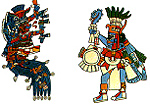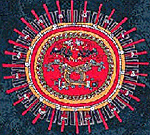 In their own embattled past, in defeat and in victory,
the Aztecs had developed a haunting sense of the
uncertainty of all power, all mortal things, even all
gods. Four Ages, they said, had ended in universal
ruin. They lived in the Fifth Age, inevitably doomed as
well to apocalyptic extinction.
In their own embattled past, in defeat and in victory,
the Aztecs had developed a haunting sense of the
uncertainty of all power, all mortal things, even all
gods. Four Ages, they said, had ended in universal
ruin. They lived in the Fifth Age, inevitably doomed as
well to apocalyptic extinction.
Portents and signs of imminent disaster filled the reign of the Aztec emperor Montezuma II. His predecessor, Nezahualpilli had warned him the end of Aztec power was near. A comet crossing the sky heralded the end of the Empire said the priests. Old men recounted dreams of the great temple of Huitzilopochtli falling in flames, an old woman dreamed of a raging river destroying the royal palace.
A noblewoman, dead four days rose from the grave to point a cadaverous finger at him and forecast that in his day the Empire would end. Fire consumed a temple of Huitziolopochtli and lightning destroyed another. On a clear calm day the waters of Lake Texcoco erupted in waves of eerie size and force, drowning people and destroying houses. Then a crippled man had worked his way from the coast to report to Montezuma that he had seen a mountain floating upon the sea.
Envoys were sent to verify the news. They climbed a tree and saw white men, with long thick beards and clothing of iron.
 Montezuma recognized it as the appearance of
Quetzalcoatl --the semi-divine being from whom the Aztecs
had seized their empire and who had promised one
day to return. Moreover it was the year One Reed -- an
anniversary of Quetzalcoatl's birth and a suitable time
for his return. Now they came towards the great city.
Spies and emissaries reported the Spaniards every
move to their sacred lord. Terrified by omens, Montezuma
spent long hours consulting his advisors, performing
sacred rites, doing penance or sitting alone
pondering the possibility that this being, bearded and
clad in metal, was really the god Quetzalcoatl returning
to claim his domain.
Montezuma recognized it as the appearance of
Quetzalcoatl --the semi-divine being from whom the Aztecs
had seized their empire and who had promised one
day to return. Moreover it was the year One Reed -- an
anniversary of Quetzalcoatl's birth and a suitable time
for his return. Now they came towards the great city.
Spies and emissaries reported the Spaniards every
move to their sacred lord. Terrified by omens, Montezuma
spent long hours consulting his advisors, performing
sacred rites, doing penance or sitting alone
pondering the possibility that this being, bearded and
clad in metal, was really the god Quetzalcoatl returning
to claim his domain.
The man, Hernando Cortes advanced with the self-confident stride of a conqueror. As he moved westward to the last of the great mountain barriers, the volcanoes Popocatepetl and Iztaccihuitl, Montezuma sent emissaries eastward. A high pass between the two volcanoes separated the parties. The November winds on the high slopes brought freezing storms and the winds whirled the volcanic sand so it seemed to attack like a hundred obsidian knives. Some would wait, Cortes continued to ascend.
Popocatepetl, an active volcano, threatened disaster. From it, wrote Cortes, "both by day and night, a great volume of smoke often comes forth and rises up into the clouds as straight as a staff..." Cortes sent men up the mountain to find out the secret of the smoke. They were near the top when more smoke gushed up, with such noise and violence that "the whole mountain seemed to fall down."
With the uncanny shuddering movement of earthquakes, prophesized the Aztec priests, the Fifth Age would die.
Upward the armored invaders climbed, past the great pines cherished by the Aztecs, leading fierce mastiffs, struggling with cannon and guarding their few re-maining precious horses in the thin cold air. From the other side of the volcano Montezuma's emissaries hurried forward, resplendent in their capes trimmed with bright tropical feathers and their jewels of jade, turquoise and gold.
As Cortes ascended, six thousand Tlascalan allies followed him, clad in quilted cotton armor. The army approached the pass. At that moment the Spaniards stood with sword and cross between two mountains profoundly sacred to the Aztecs and beheld the Valley of Mexico.
The Aztecs and Spaniards prayed to their respective gods and prepared for one of history's most momentous confrontations.
Cortes! The Conquest of the Aztecs by David W. Tschanz.
- Introduction
The Captain General: Cortes
Vera Cruz, Cempoala, Tlaxcala, and Cholula
Tenochtitlan
Breakout, Siege, and Capture
Back to Cry Havoc #38 Table of Contents
Back to Cry Havoc List of Issues
Back to MagWeb Master Magazine List
© Copyright 2002 by David W. Tschanz.
This article appears in MagWeb (Magazine Web) on the Internet World Wide Web. Other military history articles and gaming articles are available at http://www.magweb.com